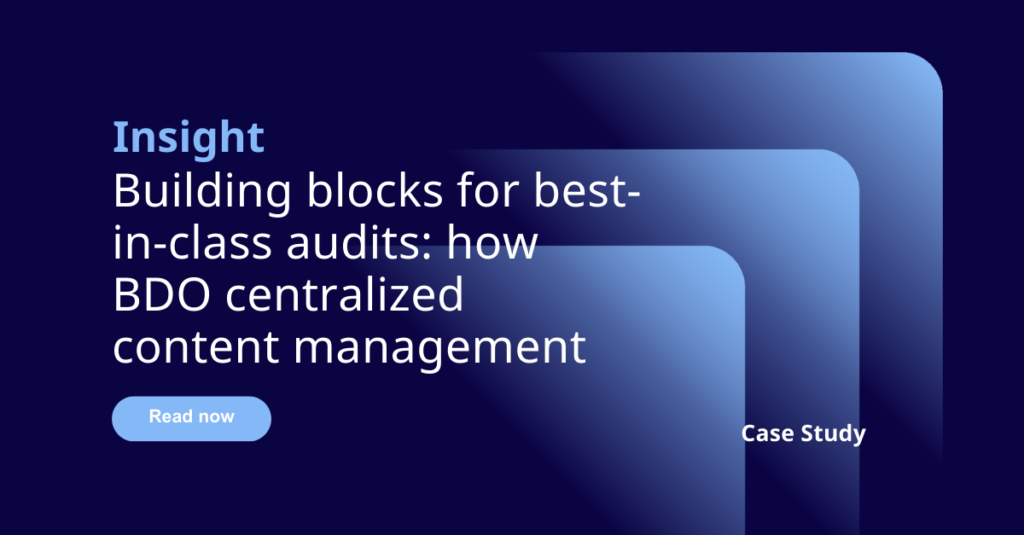Data-driven and risk-based audit methodologies have become key for delivering audit quality and efficiency. Audit firms are turning to technology to harness the power of data, obtain keen insights and deliver audits that are tailored to the profile and risk related to a client.
However, this is easier said than done. Firms are treading water in a sea of regulations and updates from standards bodies and often relying on generic systems and workarounds to operationalize them across policies and procedures.
Ultimately, the extent to which an audit methodology can be tailored is dependent on the systems in the back end. In particular, five factors influence the approach firms should take in order to improve how they support data-driven and risk-based audit methodologies.
1: Volume of methodology content and guidance
- Fragmented across audit software packages, Excel checklists, Word-based procedures, courseware/learning management systems, intranets.
- Risk of inconsistencies – is it possible to identify exactly where material needs to change or is this achieved by manually checking?
- Broken links – link rot and content drift are issues that affect all our digital lives, however, it is particularly important for compliance to manage links across the organization’s body of content.
- Quality control – is the guidance or template relevant or current?
- Ongoing maintenance – if something changes, is it easy to update across the body of material?
- Navigation – is the material easily searchable?
These issues make it difficult for auditors to obtain guidance on risks and processes based on the profile of the client.
Ultimately, the extent to which an audit methodology can be tailored is dependent on the systems in the back end.
2: Ensuring that all templates and materials are tagged appropriately
Over time, generic solutions such as SharePoint can become unwieldy and require a lot of resources to manage. When there are a lot of documents, implementing appropriate tagging is essential for firms to be able to administer their knowledge systems in totality. Tagging also enables firms to generate reports, for example on content that needs to be reviewed for updates. This allows them to holistically understand regulatory standards and their system of quality management. Additionally, tagging correctly makes content more findable down the line, whether it’s accessed in the research platform or the audit platform.
3: Granularity of guidance
Data-driven audit methodologies require firm guidance that is concise and tailored to the industry, profile, and risks related to a client.
Generic solutions can become a wasteland as employees avoid engaging with poor user experiences, cluttered designs, and unnavigable layouts. It’s easier to turn to Google to look for an answer despite the risk of inaccuracy.
Modern technology solutions can give firms complete oversight and control over content, down to the micro level. Nowadays, firms in heavily regulated industries such as audit and accounting are seeing the benefits of moving to a component-based content model which lets them create content once and reuse globally. It allows firms to manage content at a small scale, tailor for local languages, and embed in downstream platforms such as knowledge centers or research platforms. That way staff are effectively trained and informed.
4: Version control
Creating more guidance content increases the risk of version issues.
Employees need to maintain compliance with firm policies and procedures, however given the difficulty and effort involved in accessing material, keeping it up to date, and in synch across the organization, there is a risk of staff relying on incorrect material when they are designing and executing engagements. It goes without saying that firms need to be able to manage the adoption of standards however, firms also need to be able to demonstrate the adoption of standards at previous points in time and how those standards were incorporated into audits.
Rather than play a game of catch-up and firefight, firms can update systems and processes to enable a proactive approach, allowing them to be first to market with new updates and operationalize them across the organization with consistency.
5: Integration with audit platforms – embedding guidance materials in workflows
Firms can cut auditors’ need to search for guidance or switch between tools by embedding guidance in workflows. Having access to the right material at the right time improves auditor judgment and efficiency and ensures that staff are utilizing the most up to date material.
Firms in heavily regulated industries such as audit and accounting are seeing the benefits of moving to a component-based content model which lets them create content once and reuse globally.
Cultivating deep know-how
In order for staff to truly own their audit experience, firms are turning to technology to cultivate an optimal learning culture that instills deep know-how, relevance, and key insights.
Purpose-built technology solutions with the capacity to give firms total oversight and control over their content down to the micro level allow staff to sift through the noise, hone judgment, and deliver best-in-class audits. Achieving this with manual workarounds or generic technology solutions can require a lot of support and resources. Talk to us about implementing a solution that works for your organization.


